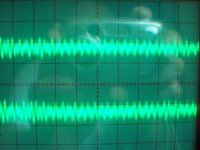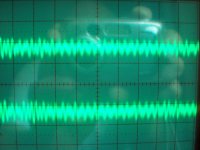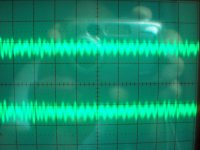Grounds
Mine two are both diy, thanks to the info provided by georgehifi. They always did have the power supply floating, no ground connection between signal and power.
The passive unit had a low level hum at first. Used resistor from signal ground to chassis to eliminate this issue. 10 - 100 ohms should work fine. Not having a connection from power ground to chassis is not savy, but in this case it is dc at about 17 volts.
In my passive the power comes from a wall wart battery charger. The kind that comes with 12 volt SLA for RC cars. Dual stage LM317's, then chokes to LED's.
The active unit with LRD attenuation powers the LED's off the +/- rails. Uses resistors to buffer the rails from reg noise and has a 1 mH inductor on each side of the LEDs.
I like to think I can hear the sonic effects of the chokes feeding the diodes. But LED's are basically noisey devices, power supply noise most likely is lower than self generated artifacts.
One thing I did to both off mine is to change to switched pots. This way the unit is powered can be up all the time, but the LED's are off. Sholuld help extend the life out to several years of hard usage. Maybe longer. Before I would open the pot up to mid level when not used to keep currents low on both elements.
Just make sure the right side of the pot gets connected to the shunt/series diodes. It needs to be maximum attenuation when switched on.
George
Mine two are both diy, thanks to the info provided by georgehifi. They always did have the power supply floating, no ground connection between signal and power.
The passive unit had a low level hum at first. Used resistor from signal ground to chassis to eliminate this issue. 10 - 100 ohms should work fine. Not having a connection from power ground to chassis is not savy, but in this case it is dc at about 17 volts.
In my passive the power comes from a wall wart battery charger. The kind that comes with 12 volt SLA for RC cars. Dual stage LM317's, then chokes to LED's.
The active unit with LRD attenuation powers the LED's off the +/- rails. Uses resistors to buffer the rails from reg noise and has a 1 mH inductor on each side of the LEDs.
I like to think I can hear the sonic effects of the chokes feeding the diodes. But LED's are basically noisey devices, power supply noise most likely is lower than self generated artifacts.
One thing I did to both off mine is to change to switched pots. This way the unit is powered can be up all the time, but the LED's are off. Sholuld help extend the life out to several years of hard usage. Maybe longer. Before I would open the pot up to mid level when not used to keep currents low on both elements.
Just make sure the right side of the pot gets connected to the shunt/series diodes. It needs to be maximum attenuation when switched on.
George
Ok we just did some blind A/B testing of some power supplies.
1 Standard supply that I give with the Lightspeed Attenuator
2 Gel Cell rechargable 12v (Model car type)
3 Alkiline 9v
4 Super Regulated Linear 12v supply that powers medical instruments, about the size of a Besser Block, and as heavy
All 3 three of us could not reliably tell which was playing.
This prompted me to do some screen shots, the Lightspeed is output is terminated with a 50k resistor, volume at 12 o'clock input attached to a muted cd player, three screen shots will follow.
1st With power supply and led - floating
2nd With power supply and led - earthed to rca earth
3rd No power supply at all
In all cases the noise and frequency did not change when the volume was at min mid or full.
The noise is in all cases .02mV peak to peak at a frequency of 185mhz.
I think that these numbers that I have given are the noise and frequency threshold of my Tektronix 400mhz scope and 400mhz probes, not of the Lightspeed itself. Becuse with the probe shorted I get the same figures.
See for yourself the differences in supply confurations in the 3 screen shots all are left channel top trace right channel bottom trace.
Cheers George
With supply and -ve floating
1 Standard supply that I give with the Lightspeed Attenuator
2 Gel Cell rechargable 12v (Model car type)
3 Alkiline 9v
4 Super Regulated Linear 12v supply that powers medical instruments, about the size of a Besser Block, and as heavy
All 3 three of us could not reliably tell which was playing.
This prompted me to do some screen shots, the Lightspeed is output is terminated with a 50k resistor, volume at 12 o'clock input attached to a muted cd player, three screen shots will follow.
1st With power supply and led - floating
2nd With power supply and led - earthed to rca earth
3rd No power supply at all
In all cases the noise and frequency did not change when the volume was at min mid or full.
The noise is in all cases .02mV peak to peak at a frequency of 185mhz.
I think that these numbers that I have given are the noise and frequency threshold of my Tektronix 400mhz scope and 400mhz probes, not of the Lightspeed itself. Becuse with the probe shorted I get the same figures.
See for yourself the differences in supply confurations in the 3 screen shots all are left channel top trace right channel bottom trace.
Cheers George
With supply and -ve floating
Attachments
All shots were taken within 2 seconds of each other, camera was tripod mounted and my dear wife was doing the conections of the -ve to rca earth and the disconection of the powersupply, 2nd and thrird shot.
What I can now confidently say is that in my setup there is no influcence on the ldr's (noise or hum) by any of the power supplies, conected or disconected, as for hum, it is hum free, and if any hum is detected is is because of system wiring, (loops and such) as the Lightspeed has no hum of it's own.
I say from this that any difference in "sound" detected is of a personal nature, and not because of a change in residual hum or noise in the Lightspeed itself.
Cheers George
What I can now confidently say is that in my setup there is no influcence on the ldr's (noise or hum) by any of the power supplies, conected or disconected, as for hum, it is hum free, and if any hum is detected is is because of system wiring, (loops and such) as the Lightspeed has no hum of it's own.
I say from this that any difference in "sound" detected is of a personal nature, and not because of a change in residual hum or noise in the Lightspeed itself.
Cheers George
mikelm said:Hi George, This noise thing a real mystery to me - I try to understand but in the end I have to go by my ears because my goal is enjoying the sound. cheers mike
Mike, the only thing that may make a difference from what I can see with your "um" decimated Lightspeed that I sent you, is that your modded one has now no advantage of the case shielding, from the power supply transformer and from air born rf, none of my point to point wiring uses shielded cable form rca's in and out to the board, it's just 99'9% oxygen free single strand copper.
Could this be the difference you are hearing?
Cheers George
were not really talking about the same thing here.
I just changed the caps from the o/p to the i/p.
with the lightspeed in it's current unboxed state these two variations give different levels of hum. With either arrangment the hum is simply not audible from the listening position and can only be detected with ones ear close to the speaker.
The fact that I get some hum with these i/p & o/p impedances and no box does not surprise me.
But with each arrangement there is a easily noticed change in the character of the sound - one sounds fast, exciting and wide open while the other sounds smooth, laidback and more enclosed.
This is the thing that I do not understand.
I will now go back to bed
cheers
mike
I just changed the caps from the o/p to the i/p.
with the lightspeed in it's current unboxed state these two variations give different levels of hum. With either arrangment the hum is simply not audible from the listening position and can only be detected with ones ear close to the speaker.
The fact that I get some hum with these i/p & o/p impedances and no box does not surprise me.
But with each arrangement there is a easily noticed change in the character of the sound - one sounds fast, exciting and wide open while the other sounds smooth, laidback and more enclosed.
This is the thing that I do not understand.
I will now go back to bed
cheers
mike
mikelm said:were not really talking about the same thing here.
I just changed the caps from the o/p to the i/p.
But with each arrangement there is a easily noticed change in the character of the sound - one sounds fast, exciting and wide open while the other sounds smooth, laidback and more enclosed.
This is the thing that I do not understand.mike
With the cap on the output you have a -3db point of .4hz with your 100k input amp. Plus who knows what 1vdc of dc offset does to the sound of the LDR's
With the cap on the input you have a -3db point 14 times higher so your not getting low sub bass, sort of a rumble filter, this can make it sound faster, depending on how low your system goes. Also gets rid of that 1vdc of dc offset on the LDR's.
Cheers George
I was having a private conversation with george about impedances and he said we should make it public .... so here it is
Hi George,
I have measured the i/p and o/p impedances of the lightspeed several times since it arrived and I consistently get the following figures:
-------------low mid high
i/p imp: right 46k 38k 48
---------left 66k 39k 44k
measured with amp connected but turned off and trimmer pot set to zero. The mid point is electrical midpoint
-------------low mid high
o/p imp: right 83 14k 300
---------left 88 15k 250
measured with i/p short cct and trimmer pot set to zero
these values seem fine to me but are different to from what you have mentioned on the thread.
just for your information
cheers
mike
Hi George,
I have measured the i/p and o/p impedances of the lightspeed several times since it arrived and I consistently get the following figures:
-------------low mid high
i/p imp: right 46k 38k 48
---------left 66k 39k 44k
measured with amp connected but turned off and trimmer pot set to zero. The mid point is electrical midpoint
-------------low mid high
o/p imp: right 83 14k 300
---------left 88 15k 250
measured with i/p short cct and trimmer pot set to zero
these values seem fine to me but are different to from what you have mentioned on the thread.
just for your information
cheers
mike
Mike the way to measure the output impedance is not how you have done, from output to ground with a DMM.
It is the total series resistance from the output (Lightspeed) to the source (CD) or (input Lightspeed) that is the output impedance of the Lightspeed.
Please don't take the next 2 parragraphs to heart as I'm a grumpy old ----, and I hate seeing people waisting their time and maybe blowing something up when there's other things that can be improved upon. Even my customers have to be smacked around the head a little from time to time.
As I said in the PM's these LDR's are very prone to damage or blowing if measured or wired wrong, please be carefull as if one blows or becomes faulty, you need to match up a whole new quad set, and this is whole new world of hurt, because of my potting and the matching labour you will be in for.
The way I have set the Lightspeed up is the best that can be done with the near 35years of experience doing them, concetrate more on getting the amps and source impedances right with no DC offset present and preferably dc coupled all the way through, and you will gain more tweakability doing this, than trying to improve the standard stereo Lightspeed as I have made it.
Cheers George
It is the total series resistance from the output (Lightspeed) to the source (CD) or (input Lightspeed) that is the output impedance of the Lightspeed.
Please don't take the next 2 parragraphs to heart as I'm a grumpy old ----, and I hate seeing people waisting their time and maybe blowing something up when there's other things that can be improved upon. Even my customers have to be smacked around the head a little from time to time.
As I said in the PM's these LDR's are very prone to damage or blowing if measured or wired wrong, please be carefull as if one blows or becomes faulty, you need to match up a whole new quad set, and this is whole new world of hurt, because of my potting and the matching labour you will be in for.
The way I have set the Lightspeed up is the best that can be done with the near 35years of experience doing them, concetrate more on getting the amps and source impedances right with no DC offset present and preferably dc coupled all the way through, and you will gain more tweakability doing this, than trying to improve the standard stereo Lightspeed as I have made it.
Cheers George
Hi George,
My lightspeed is now set up in the way you recommended - Caps on I/P - zero offset.
The output impedance of my cd player is 20 ohms.
When I measured o/p impedance of the lightspeed I shorted the lightspeed inputs.
So I have to somehow add in this 20 ohms to my results ?
Is this what you mean ?
I still don't see that it will significantly change the figures I have posted.
This is not a big deal for me.
However I set up this thing it is still the best pre-amp that I ever heard and I am really enjoying it - but I do like to understand. If there is something that I have missed I'm happy for you to tell me what it is.
cheers
mike
My lightspeed is now set up in the way you recommended - Caps on I/P - zero offset.
The output impedance of my cd player is 20 ohms.
When I measured o/p impedance of the lightspeed I shorted the lightspeed inputs.
So I have to somehow add in this 20 ohms to my results ?
Is this what you mean ?
I still don't see that it will significantly change the figures I have posted.
This is not a big deal for me.
However I set up this thing it is still the best pre-amp that I ever heard and I am really enjoying it - but I do like to understand. If there is something that I have missed I'm happy for you to tell me what it is.
cheers
mike
- Home
- Source & Line
- Analog Line Level
- Lightspeed Attenuator a new passive preamp


